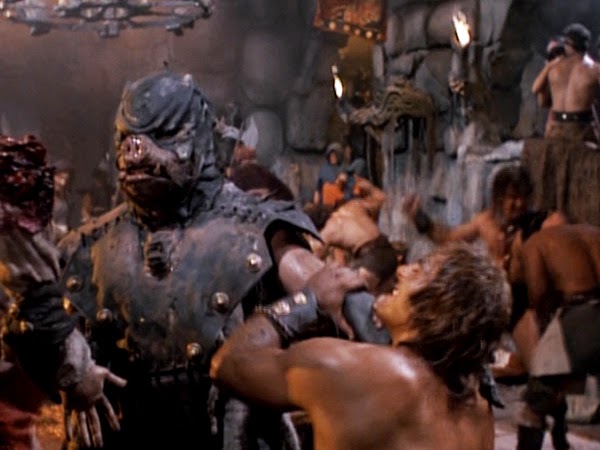But really, what's there to say?
"There has been an awakening. Have you felt it?"
Lots of theorizing about whose voice this is. I want it to be Max von Sydow, who's supposed to be in this movie. I want to see him be the villain and go all Ming-the-Merciless on the Star Wars universe. Why not? After all, there's a direct line between Flash Gordon and Star Wars.
Then we get freaked-out Stormtrooper. My favorite explanation for him is that he got separated from his squad when he ducked behind a dune and did some Tatooine peyote.
But seriously, clearly not a clone of any Fet we've ever met. Is he a crashed Tie-pilot? A Stormtrooper who's gone AWOL? A Republican in disguise? (The Rebels won, right? So shouldn't there be a new republic? If that's the case, shouldn't the folks who used to be Rebels now be Republicans?) (Oh, and no, that's not a political statement, though now that I go back and read that, I can see why they absolutely won't be called Republicans. >.< Just so long as they're not called Rebels because that implies they still have something to rebel against. Unless, of course, they do, but that would feel both extremely lazy on the parts of the writers and undercutting the victory at the end of Jedi.)
And, ever so faintly, at about 0:25, you can hear the sounds of an imperial probe droid, sounding exactly like the one that Han and Chewie killed on Hoth. Is he being hunted by someone?
Cute soccer droid! Seriously, if you needed any indication that international bank was vital to the success of movies, this is it. R2-D2 has been turned into a soccer ball. Though even making worried boop-beep-boop noises doesn't save this from totally undercutting the tension the music is trying to build.
Happy Stormtroopers! So clearly, somebody's not just using the old symbology and Imperial look-and-feel, but has been improving on it as well: new armor, new assault blasters (with noticeably bigger scopes; can these guys hit what they're shooting at?). So either:
A) the Empire's still alive and well, either in pockets or is actually still calling the shots in most of the galaxy, in spite of the death of Palpatine and the destruction of much of their fleet at the Battle of Endor.
B) or somebody's attempting to resurrect it. This is the less lazy option, honestly, but the more difficult to pull off.
Cute scavenger girl! Her goggles, apparently, are fashioned from the lenses of an original-trilogy era Stormtrooper visor. Her ride looks a lot like Luke's at the beginning of New Hope turned on its side. And if you freeze the screen at 0:39, you'll see, strapped to the side of her ride, what looks like a lightsaber on the end of a long pole. The link between samurai and jedi has been made repeatedly. Is this a jedi version of the traditional weapon of the onna-bugeisha, the naginata?
As she takes off, you hear more lovely Star Wars engine sounds. The Star Wars universe has probably one of the most recognizable soundscapes out there, and the new crew appears to be milking it for all its worth.
Have you noticed how long the pauses of black screen are? They're just a touch too long, to induce you to sit forward impatiently while you wait for the next scene.
X-wings! Our pilot looks clean-shaven, but his helmet has those scratches and dings we associate with the Star Wars universe. (Though, arguably, it should look nicer and cleaner because the Rebellion won. Didn't it?) Hot-dogging x-wings coming low over a lake. The only planet we've seen so far that looks like this is Naboo. Why so low? Training exercise? Attempting to come in below someone's radar?
If you look closely, you can tell that these are not duplicates of the x-wings Luke flew. The engines appear to be solid to the body, with the folding wings stretching out from them. Some have suggested these are closer in design to Ralph McQuarrie's concept art.
Oops! AWOL scene from Game of Thrones! Seriously, cloaked dude in a snowy wood? Is winter coming? "The Dark Side... and the Light."
And here we get what's become the most controversial bit of the trailer: the cruciform lightsaber.
Only, I'm not sure this is a lightsaber. Oh, sure, it's a laser-sword of some sort, but notice the sound is off? That it sputters and flickers more? That the blade is longer and thinner? It looks like a cheap knock-off of a lightsaber, honestly.
Since the original series, there's been a huge revival in what folks are calling the Western Martial Arts, mostly involving the swordfighting techniques of Western Europe. It would be cool to see some of that in a Star Wars movie.
That said, a lot of longsword play had you grabbing the blade for leverage, or to bash people with the quillions. While these quillions look pretty deadly, grabbing the blade looks like a good way to lose your fingers. Maybe this crossguard is simply the logical response to the Skywalker penchant for cutting people's hands off?
WOOHOO! The music, the Falcon, the getting-dizzy-in-your-seat barnstorming, the howl-and-rattle of attacking tie fighters. Fans over the age of 30 just got hooked; we're gonna see this thing no matter what else you tell us about it. :p
Seriously, the Falcon looks great, and it's fun to see it rolling and swooping over the sands to launch head-first into the ties.
Que title, que date, fade to black and give us a lightsaber sound. Seriously? Why end with that? Weird...
But there you go. So far, they've proven they've gotten the basics down. If this trailer's any indication, The Force Awakens will look and sound like a Star Wars movie. Well done to everyone involved. I'm very much looking forward to seeing more.





























